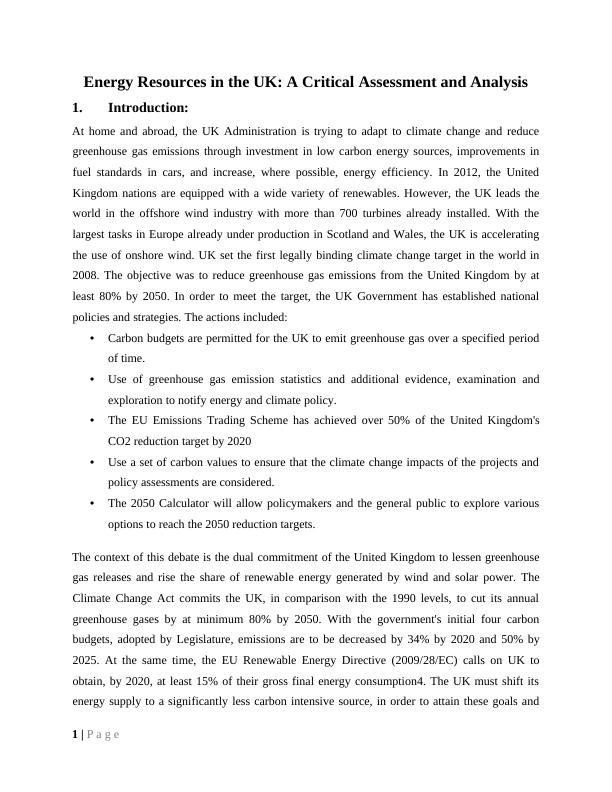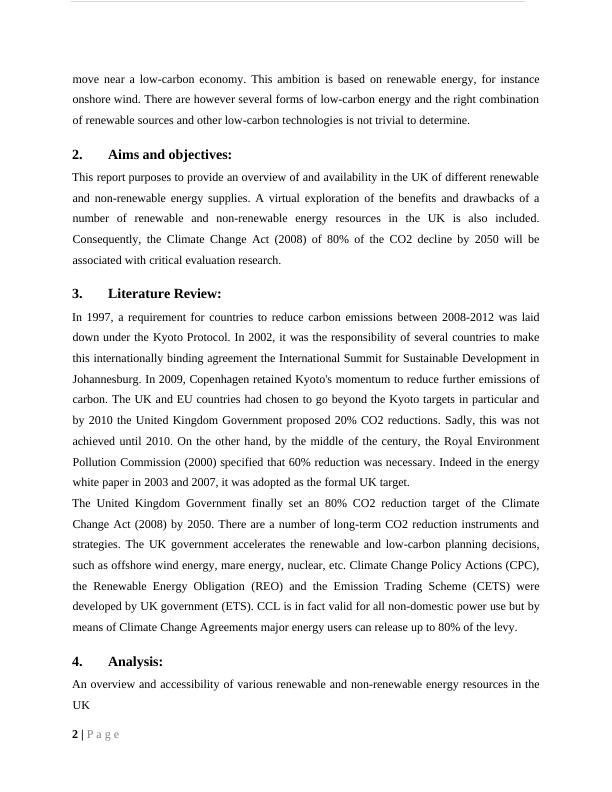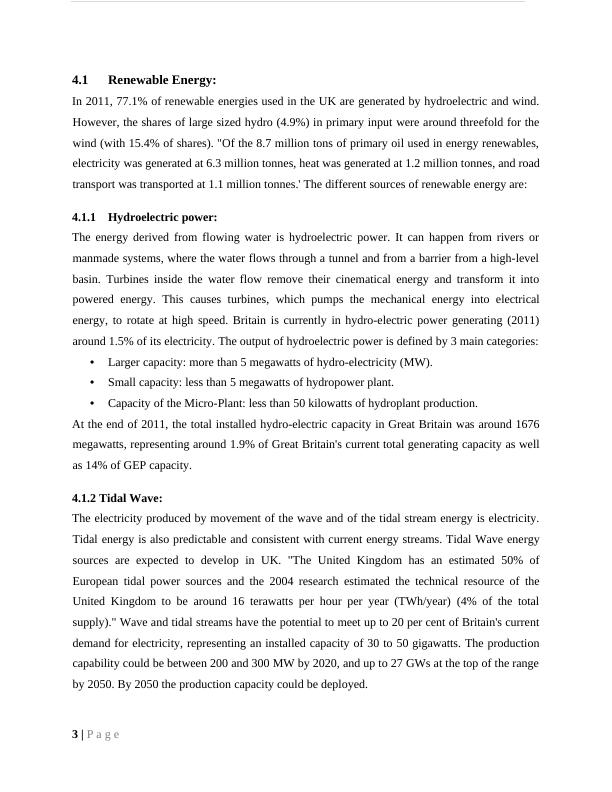Ask a question from expert
Energy Resource and Use Analysis pdf
8 Pages2759 Words51 Views
Added on 2021-03-25
Energy Resource and Use Analysis pdf
Added on 2021-03-25
BookmarkShareRelated Documents
Energy Resources in the UK: A Critical Assessment and Analysis1.Introduction: At home and abroad, the UK Administration is trying to adapt to climate change and reducegreenhouse gas emissions through investment in low carbon energy sources, improvements infuel standards in cars, and increase, where possible, energy efficiency. In 2012, the UnitedKingdom nations are equipped with a wide variety of renewables. However, the UK leads theworld in the offshore wind industry with more than 700 turbines already installed. With thelargest tasks in Europe already under production in Scotland and Wales, the UK is acceleratingthe use of onshore wind. UK set the first legally binding climate change target in the world in2008. The objective was to reduce greenhouse gas emissions from the United Kingdom by atleast 80% by 2050. In order to meet the target, the UK Government has established nationalpolicies and strategies. The actions included:•Carbon budgets are permitted for the UK to emit greenhouse gas over a specified periodof time.•Use of greenhouse gas emission statistics and additional evidence, examination andexploration to notify energy and climate policy.•The EU Emissions Trading Scheme has achieved over 50% of the United Kingdom'sCO2 reduction target by 2020•Use a set of carbon values to ensure that the climate change impacts of the projects andpolicy assessments are considered.•The 2050 Calculator will allow policymakers and the general public to explore variousoptions to reach the 2050 reduction targets.The context of this debate is the dual commitment of the United Kingdom to lessen greenhousegas releases and rise the share of renewable energy generated by wind and solar power. TheClimate Change Act commits the UK, in comparison with the 1990 levels, to cut its annualgreenhouse gases by at minimum 80% by 2050. With the government's initial four carbonbudgets, adopted by Legislature, emissions are to be decreased by 34% by 2020 and 50% by2025. At the same time, the EU Renewable Energy Directive (2009/28/EC) calls on UK toobtain, by 2020, at least 15% of their gross final energy consumption4. The UK must shift itsenergy supply to a significantly less carbon intensive source, in order to attain these goals and1 | P a g e

move near a low-carbon economy. This ambition is based on renewable energy, for instanceonshore wind. There are however several forms of low-carbon energy and the right combinationof renewable sources and other low-carbon technologies is not trivial to determine.2. Aims and objectives: This report purposes to provide an overview of and availability in the UK of different renewableand non-renewable energy supplies. A virtual exploration of the benefits and drawbacks of anumber of renewable and non-renewable energy resources in the UK is also included.Consequently, the Climate Change Act (2008) of 80% of the CO2 decline by 2050 will beassociated with critical evaluation research.3.Literature Review: In 1997, a requirement for countries to reduce carbon emissions between 2008-2012 was laiddown under the Kyoto Protocol. In 2002, it was the responsibility of several countries to makethis internationally binding agreement the International Summit for Sustainable Development inJohannesburg. In 2009, Copenhagen retained Kyoto's momentum to reduce further emissions ofcarbon. The UK and EU countries had chosen to go beyond the Kyoto targets in particular andby 2010 the United Kingdom Government proposed 20% CO2 reductions. Sadly, this was notachieved until 2010. On the other hand, by the middle of the century, the Royal EnvironmentPollution Commission (2000) specified that 60% reduction was necessary. Indeed in the energywhite paper in 2003 and 2007, it was adopted as the formal UK target. The United Kingdom Government finally set an 80% CO2 reduction target of the ClimateChange Act (2008) by 2050. There are a number of long-term CO2 reduction instruments andstrategies. The UK government accelerates the renewable and low-carbon planning decisions,such as offshore wind energy, mare energy, nuclear, etc. Climate Change Policy Actions (CPC),the Renewable Energy Obligation (REO) and the Emission Trading Scheme (CETS) weredeveloped by UK government (ETS). CCL is in fact valid for all non-domestic power use but bymeans of Climate Change Agreements major energy users can release up to 80% of the levy.4.Analysis: An overview and accessibility of various renewable and non-renewable energy resources in theUK2 | P a g e

4.1 Renewable Energy: In 2011, 77.1% of renewable energies used in the UK are generated by hydroelectric and wind.However, the shares of large sized hydro (4.9%) in primary input were around threefold for thewind (with 15.4% of shares). "Of the 8.7 million tons of primary oil used in energy renewables,electricity was generated at 6.3 million tonnes, heat was generated at 1.2 million tonnes, and roadtransport was transported at 1.1 million tonnes.' The different sources of renewable energy are:4.1.1 Hydroelectric power: The energy derived from flowing water is hydroelectric power. It can happen from rivers ormanmade systems, where the water flows through a tunnel and from a barrier from a high-levelbasin. Turbines inside the water flow remove their cinematical energy and transform it intopowered energy. This causes turbines, which pumps the mechanical energy into electricalenergy, to rotate at high speed. Britain is currently in hydro-electric power generating (2011)around 1.5% of its electricity. The output of hydroelectric power is defined by 3 main categories:•Larger capacity: more than 5 megawatts of hydro-electricity (MW).•Small capacity: less than 5 megawatts of hydropower plant.•Capacity of the Micro-Plant: less than 50 kilowatts of hydroplant production.At the end of 2011, the total installed hydro-electric capacity in Great Britain was around 1676megawatts, representing around 1.9% of Great Britain's current total generating capacity as wellas 14% of GEP capacity.4.1.2 Tidal Wave: The electricity produced by movement of the wave and of the tidal stream energy is electricity.Tidal energy is also predictable and consistent with current energy streams. Tidal Wave energysources are expected to develop in UK. "The United Kingdom has an estimated 50% ofEuropean tidal power sources and the 2004 research estimated the technical resource of theUnited Kingdom to be around 16 terawatts per hour per year (TWh/year) (4% of the totalsupply)." Wave and tidal streams have the potential to meet up to 20 per cent of Britain's currentdemand for electricity, representing an installed capacity of 30 to 50 gigawatts. The productioncapability could be between 200 and 300 MW by 2020, and up to 27 GWs at the top of the rangeby 2050. By 2050 the production capacity could be deployed.3 | P a g e

End of preview
Want to access all the pages? Upload your documents or become a member.
Related Documents
Energy and Efficiency: Strategies for Clean Energy Adoptionlg...
|15
|785
|82
Assignment on Sustainable Energy PDFlg...
|23
|6111
|56
The Carbon Emission Reduction Dilemma – COP26 Glasgowlg...
|7
|1391
|71
(solved) Essay on Greenhouse Gaslg...
|10
|2008
|61
CO2 Emission Reduction Studylg...
|8
|1481
|47
Smart Energy | Assignment-1lg...
|9
|1654
|20